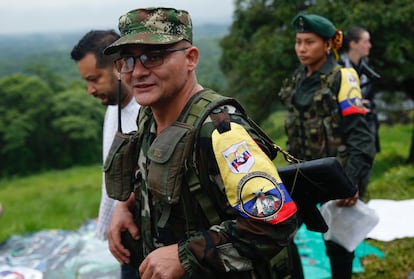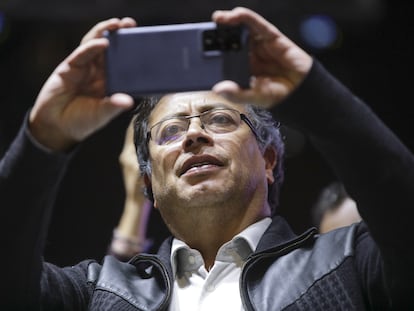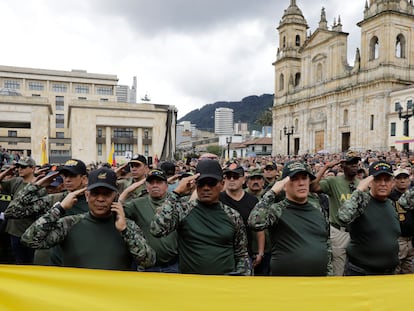The fires never stopped: Petro looks for new ways to achieve ‘total peace’ in Colombia
The end of a ceasefire between the Colombian government and an armed group known as the Estado Mayor Central (EMC) has put new pressure on the disarmament process

Colombian President Gustavo Petro’s ambitious “total peace” policy began at the start of this year with five big promises… which were then followed by three big setbacks.
2023 began with the president announcing and celebrating a bilateral ceasefire with five armed groups of guerillas: the National Liberation Army (ELN), former FARC guerillas that make up the Segunda Marquetalia and the Central General Staff (EMC), the Clan del Golfo and the Self-Defense Forces of the Sierra Nevada. “Total peace will be a reality,” the president announced, on December 31 of 2022. But the good news of the new year has quickly faded away. Five months later, there is no longer a bilateral ceasefire with three of those five organizations: the ELN, the Clan del Golfo and, more recently, with the Central General Staff. This means that – at least formally – the military offensive against the three largest illegal organizations in the country has resumed.
The ELN never got on board: a few days after Petro’s announcement, the armed group’s leadership clarified – with much annoyance – that such an agreement had never been reached at the negotiating table. To this day, it still has not. As for the Clan del Golfo – a neo-paramilitary group and drug cartel, whose political status has not been recognized by the Colombian government – the ceasefire ended in mid-March, by order of the president. The group will continue to impose its terror in various parts of the country, having shown no willingness to have a dialogue.
The so-called Central General Staff (EMC) – a federation of dissident groups from the now-extinct FARC, headed by Iván Mordisco – had a golden opportunity to negotiate. In addition to the ceasefire, the government had recognized its political nature – a step towards opening a peace negotiation back in March. According to three analysts consulted, the government and the EMC’s commanders had opened a good line of communication. But President Petro announced the end of the ceasefire after the murder of four young Indigenous people at the hands of one of the EMC’s groups – the so-called Carolina Ramírez Front – in Putumayo.
In addition to these killings, the EMC has continued to forcibly recruit minors. “Killing Indigenous children is an inadmissible crime against humanity. The same goes for forcibly recruiting minors,” Petro wrote on his Twitter account this past Monday, announcing that military operations against the criminal group would be reactivated in 72 hours. However, the end to the ceasefire will have limited scope, since the military offensive will only be resumed in the departments (regions) of Meta, Caquetá, Guaviare and Putumayo – the areas where the EMC is strongest. Meanwhile, the EMC – which claims that the Colombian Army wasn’t complying with the ceasefire in the first place – is now threatening that the president’s decision will “unleash war.”
The end of this ceasefire does not mean that the negotiation table is packed up for good. It also allows Petro to comply with a recommendation that several critics have made: to maintain peace talks without stopping the military offensive. In other words, the successive announcements to terminate three ceasefires are a turning point in the government’s handling of the “total peace” policy.
“All this shows that Petro was wrong when he offered the groups a ceasefire without [forcing them to make commitments]... nobody has complied with it,” says León Valencia, a political analyst and director of the Peace and Reconciliation Foundation (Pares) in Bogotá. “In December, Petro thought that the bilateral ceasefire was going to have a big resonance, due to the clamor for peace… but several of these armed groups took the opportunity to continue growing,” he adds. Valencia sees this as a political move that went wrong for the president and will give way to a period of militarized confrontation.
Laura Bonilla – deputy director of Pares – agrees, but with a more optimistic tone. “I see it as good news,” she says, regarding the shift in the “total peace” policy. “The ELN and the EMC continue to dispute territorial control, [creating] many victims. As the illegal actors continue to fight among themselves, this traditional formula of a bilateral ceasefire has not worked in recent months. Instead, now, what can be demanded at the negotiating table… is to not cede the state’s control over the territories and [to protect] victims.”
“I believe that, since he presented his security policy on May 16, the president is not renouncing the horizon of total peace… rather, he is redirecting it,” she concludes.
The total peace policy had succeeded in drastically reducing confrontations between the military and illegal armed groups, which generally benefits civilians, who are always caught in the crossfire. But illegal activities in general – along with clashes between illegal groups – have not diminished. The number of rural displacements, for example, increased in some municipalities along the Pacific, as well as in southwestern Colombia, where several organizations have a presence and clash with each other.
Now, Petro is asking that a bilateral ceasefire not be raised again without guaranteeing the safety of civilians. He also has made it clear that the state should not cede authority of the territory to the armed forces. “A ceasefire means cessation of hostilities against the civilian population, entry of the civil state into the area to transform [illicit] economies into prosperous economies for the peasantry [and] agreements to support the troops in conflict,” the president wrote on Twitter.
Elizabeth Dickinson – a senior analyst for Colombia at the International Crisis Group – regrets, however, that the ceasefire with the EMC has reached this point: she finds that, although it was advancing slowly, it was already having some positive results. For instance, a robust monitoring mechanism was being put in place in conflict zones. “It was a protocol that could be replicated” in other areas, she laments.
In the end, resuming the military offensive does not endanger the civilian population any less. “This crisis in ‘total peace’ is taking its toll on the citizenry… on the civilians who are living in areas like Putumayo, Caquetá, Guaviare and Meta, where [military] operations can start up again,” warns Dickinson.
Sign up for our weekly newsletter to get more English-language news coverage from EL PAÍS USA Edition
Tu suscripción se está usando en otro dispositivo
¿Quieres añadir otro usuario a tu suscripción?
Si continúas leyendo en este dispositivo, no se podrá leer en el otro.
FlechaTu suscripción se está usando en otro dispositivo y solo puedes acceder a EL PAÍS desde un dispositivo a la vez.
Si quieres compartir tu cuenta, cambia tu suscripción a la modalidad Premium, así podrás añadir otro usuario. Cada uno accederá con su propia cuenta de email, lo que os permitirá personalizar vuestra experiencia en EL PAÍS.
¿Tienes una suscripción de empresa? Accede aquí para contratar más cuentas.
En el caso de no saber quién está usando tu cuenta, te recomendamos cambiar tu contraseña aquí.
Si decides continuar compartiendo tu cuenta, este mensaje se mostrará en tu dispositivo y en el de la otra persona que está usando tu cuenta de forma indefinida, afectando a tu experiencia de lectura. Puedes consultar aquí los términos y condiciones de la suscripción digital.
More information
Archived In
Últimas noticias
The metaverse, four years later: Is it finished or just at a standstill?
$3,000 and a plane ticket: The United States increases incentives for migrants to self-deport before the end of the year
Charles Dubouloz, mountaineering star, retires at 36 with a farewell tour inspired by Walter Bonatti
From the White House to diplomatic gifts: Lego wins over adult fans, brick by brick
Most viewed
- The low-cost creative revolution: How technology is making art accessible to everyone
- Christian Louboutin: ‘Young people don’t want to be like their parents. And if their parents wear sneakers, they’re going to look for something else’
- All the effects of gentrification in one corner of Mexico’s Colonia Roma
- Christmas loses its festive spirit: ICE fears cast shadow over religious celebrations
- Liset Menéndez de la Prida, neuroscientist: ‘It’s not normal to constantly seek pleasure; it’s important to be bored, to be calm’











































